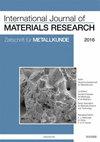Thermodynamic calculation of phase equilibria of rare earth metals with boron binary systems
IF 0.7
4区 材料科学
Q4 METALLURGY & METALLURGICAL ENGINEERING
引用次数: 4
Abstract
Abstract In order to develop novel materials based on rare earth (RE) boride and/or transition metals, phase equilibria and thermodynamic information of the RE–B based alloys are indispensable. On the basis of experimental phase equilibria and thermodynamic properties, thermodynamic assessments of the RE–B (RE = La, Sm, Gd and Tb) binary systems were carried out by the CALPHAD (Calculation of Phase Diagram) method. Self-consistent parameters of the RE–B (RE = La, Sm, Gd and Tb) binary systems were obtained, which can be used to reproduce well the experimental data. Furthermore, in combination with the previous assessments of the RE–B binary systems in the literature, phase equilibria and thermodynamic properties of the RE–B (RE = La, Ce, Pr, Nd, Sm, Gd, Tb, Dy, Ho, Er, Tm and Lu) binary systems are discussed systematically. The tendency of phase equilibria and thermodynamic information as a function of RE atomic number is demonstrated. In general, the enthalpy of mixing of liquid RE–B alloys and the enthalpy of formation of the RE–B intermetallic compounds become more and more negative with the increase in RE atomic number (except for La, Ce, Pr and Nd), while the phase transition temperatures for the RE–B intermetallic compounds increase gradually.稀土金属硼二元体系相平衡的热力学计算
为了开发基于稀土硼化物和/或过渡金属的新型材料,稀土硼基合金的相平衡和热力学信息是必不可少的。在实验相平衡和热力学性质的基础上,采用相图计算(CALPHAD)方法对RE - b (RE = La, Sm, Gd和Tb)二元体系进行了热力学评价。得到了RE - b (RE = La, Sm, Gd和Tb)二元体系的自洽参数,可以很好地再现实验数据。此外,结合前人对RE - b二元体系的评价,系统地讨论了RE - b (RE = La, Ce, Pr, Nd, Sm, Gd, Tb, Dy, Ho, Er, Tm和Lu)二元体系的相平衡和热力学性质。证明了相平衡和热力学信息随稀土原子序数的变化趋势。总的来说,随着RE原子序数的增加,液态RE - b合金的混合焓和RE - b金属间化合物的生成焓越来越负(La、Ce、Pr和Nd除外),而RE - b金属间化合物的相变温度逐渐升高。
本文章由计算机程序翻译,如有差异,请以英文原文为准。
求助全文
约1分钟内获得全文
求助全文
来源期刊
CiteScore
1.30
自引率
12.50%
发文量
119
审稿时长
6.4 months
期刊介绍:
The International Journal of Materials Research (IJMR) publishes original high quality experimental and theoretical papers and reviews on basic and applied research in the field of materials science and engineering, with focus on synthesis, processing, constitution, and properties of all classes of materials. Particular emphasis is placed on microstructural design, phase relations, computational thermodynamics, and kinetics at the nano to macro scale. Contributions may also focus on progress in advanced characterization techniques. All articles are subject to thorough, independent peer review.

 求助内容:
求助内容: 应助结果提醒方式:
应助结果提醒方式:


